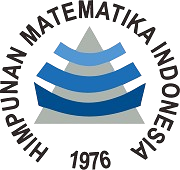The Effect of Nanoparticles on Drug Distribution in The Mathematical Model of Blood Flow
DOI:
https://doi.org/10.30736/voj.v6i1.966Keywords:
Mathematics Modeling, Fluid Flow, Blood Flow, NanoparticlesAbstract
This research examines the influence of nanoparticles in the distribution of drugs in healthy blood flow on linear, angular velocity and blood temperature. Construction and simplification of a blood flow model based on boundary layer equations, dimensionless variables, stream functions, and similarity variables. The initial step is to establish a dimensional blood flow model. Using dimensionless variables, the equation is simplified into a dimensionless equation. A similarity equation is generated by converting the non-dimensional equation. The nanoparticles used are . At the linear velocity and temperature of blood flow is in the highest position. At the angular velocity of blood flow, the position of blood flow with nanoparticles is in the uppermost position. This research is used to estimate the velocity and temperature of blood flow with the influence of nanoparticles as drug distribution.
Downloads
References
Ahmed, A., & Nadeem, S. (2016). The study of (Cu, TiO2, Al2O3) nanoparticles as antimicrobials of blood flow through diseased arteries. Journal of Molecular Liquids, 216, 615–623. https://doi.org/10.1016/j.molliq.2016.01.059
Ali, Z., Rabiei, F., Rashidi, M. M., & Khodadadi, T. (2022). A fractional-order mathematical model for COVID-19 outbreak with the effect of symptomatic and asymptomatic transmissions. European Physical Journal Plus, 137(3). https://doi.org/10.1140/epjp/s13360-022-02603-z
Alsenafi, A., & Ferdows, M. (2022). Similarity and Finite Difference Solution on Biomagnetic Flow and Heat Transfer of Blood-Fe3O4 through a Thin Needle. Journal of Mathematics, 2022. https://doi.org/10.1155/2022/1464695
Bertaglia, G., Caleffi, V., & Valiani, A. (2020). Modeling blood flow in viscoelastic vessels: the 1D augmented fluid–structure interaction system. Computer Methods in Applied Mechanics and Engineering, 360. https://doi.org/10.1016/j.cma.2019.112772
Dhange, M., Sankad, G., Safdar, R., Jamshed, W., Eid, M. R., Bhujakkanavar, U., Gouadria, S., & Chouikh, R. (2022). A mathematical model of blood flow in a stenosed artery with post-stenotic dilatation and a forced field. PLoS ONE, 17(7 July). https://doi.org/10.1371/journal.pone.0266727
Fahmi, M. Z. (2020). Nanoteknologi dalam Perspektif Kesehatan. Airlangga University Press.
Gul, T., Usman, M., Khan, I., Nasir, S., Saeed, A., Khan, A., & Ishaq, M. (2021). Magneto hydrodynamic and dissipated nanofluid flow over an unsteady turning disk. Advances in Mechanical Engineering, 13(7), 1–11. https://doi.org/10.1177/16878140211034392
Hu, X., Liu, X., Wang, H., Xu, L., Wu, P., Zhang, W., Niu, Z., Zhang, L., & Gao, Q. (2023). A novel physics-based model for fast computation of blood flow in coronary arteries. BioMedical Engineering Online, 22(1). https://doi.org/10.1186/s12938-023-01121-y
Karthik, A., Kumar, P. T. V. P., & Radhika, T. S. L. (2022). A Mathematical Model for Blood Flow Accounting for the Hematological Disorders. Computational and Mathematical Biophysics, 10(1), 184–198. https://doi.org/10.1515/cmb-2022-0136
Khalid, A. K., Othman, Z. S., & M Shafee, C. T. M. N. (2021). A review of mathematical modelling of blood flow in human circulatory system. Journal of Physics: Conference Series, 1988(1). https://doi.org/10.1088/1742-6596/1988/1/012010
Norasia, Y., Tafrikan, M., Ghani, M., Islam, U., Walisongo, N., Technology, D. S., & Airlangga, U. (2022). Laminar Viscous Fluid Flow with Micro-rotation Capabilities through Cylindrical Surface. 6(4), 865–875.
Norasia, Y., Tafrikan, M., & Kamaluddin, B. H. (2023). ANALYSIS OF THE MAGNETOHYDRODYNAMICS NANOVISCOUS FLUID BASED ON VOLUME FRACTION AND THERMOPHYSICAL PROPERTIES. BAREKENG: Jurnal Ilmu Matematika Dan Terapan, 17(1), 0331–0340. https://doi.org/10.30598/barekengvol17iss1pp0331-0340
Owasit, P., & Sriyab, S. (2021). Mathematical modeling of non-Newtonian fluid in arterial blood flow through various stenoses. Advances in Difference Equations, 2021(1). https://doi.org/10.1186/s13662-021-03492-9
Saeed, A., Khan, N., Gul, T., Kumam, W., Alghamdi, W., & Kumam, P. (2021). The flow of blood-based hybrid nanofluids with couple stresses by the convergent and divergent channel for the applications of drug delivery. Molecules, 26(21). https://doi.org/10.3390/molecules26216330
Saqr, K. M., Tupin, S., Rashad, S., Endo, T., Niizuma, K., Tominaga, T., & Ohta, M. (2020). Physiologic blood flow is turbulent. Scientific Reports, 10(1), 1–12. https://doi.org/10.1038/s41598-020-72309-8
Shah, S. R., & Kumar, R. (2020). Mathematical Modeling of Blood Flow With the Suspension of Nanoparticles Through a Tapered Artery With a Blood Clot. Frontiers in Nanotechnology, 2. https://doi.org/10.3389/fnano.2020.596475
Singh, P., Pandit, S., Mokkapati, V. R. S. S., Garg, A., Ravikumar, V., & Mijakovic, I. (2018). Gold nanoparticles in diagnostics and therapeutics for human cancer. In International Journal of Molecular Sciences (Vol. 19, Issue 7). MDPI AG. https://doi.org/10.3390/ijms19071979
Ullah, H., Lu, D., Siddiqui, A. M., Haroon, T., & Maqbool, K. (2020). Hydrodynamical study of creeping maxwell fluid flow through a porous slit with uniform reabsorption and wall slip. Mathematics, 8(10), 1–22. https://doi.org/10.3390/math8101852
Wei, H., Moria, H., Nisar, K. S., Ghandour, R., Issakhov, A., Sun, Y. L., Kaood, A., & Youshanlouei, M. M. (2021). Effect of volume fraction and size of Al2O3nanoparticles in thermal, frictional and economic performance of circumferential corrugated helical tube. Case Studies in Thermal Engineering, 25(February), 100948. https://doi.org/10.1016/j.csite.2021.100948
Yoshikawa, Y. ., Nakamoto, M. ., & Nakamura, M. et al. (2020). On-site evaluation of CT-based fractional flow reserve using simple boundary conditions for computational fluid dynamics. Int J Cardiovasc Imaging, 36, 337–346.
Yusuf, A., Almotairy, A. R. Z., Henidi, H., Alshehri, O. Y., & Aldughaim, M. S. (2023). Nanoparticles as Drug Delivery Systems: A Review of the Implication of Nanoparticles’ Physicochemical Properties on Responses in Biological Systems. In Polymers (Vol. 15, Issue 7). MDPI. https://doi.org/10.3390/polym15071596
Zaman, A., Ali, N., & Sajjad, M. (2019). Effects of nanoparticles (Cu, TiO2, Al2O3) on unsteady blood flow through a curved overlapping stenosed channel. Mathematics and Computers in Simulation, 156, 279–293. https://doi.org/10.1016/j.matcom.2018.08.012
Downloads
Published
How to Cite
Issue
Section
License
Copyright (c) 2024 Yolanda Norasia, Ajeng Oxa Nisa, Sitti Rosnafi'an Sumardi

This work is licensed under a Creative Commons Attribution-NonCommercial-ShareAlike 4.0 International License.
Copyright:
Authors who publish their manuscripts in this Journal agree to the following conditions:
- Copyright of any article on Vygotsky: Jurnal Pendidikan Matematika dan Matematika is held solely by the author under the Creative Commons Attribution 4.0 International license (CC BY NC SA).
- Authors can submit papers separately, arrange non-exclusive distribution of manuscripts that have been published in this journal into other versions (e.g. sending to the author's institutional repository, publication in a book, etc.) by acknowledging that the manuscript has been published for the first time in Vygotsky: Jurnal Pendidikan Matematika dan Matematika.
License:
Vygotsky: Jurnal Pendidikan Matematika dan Matematika is published under the terms of the Creative Commons Attribution 4.0 International License (CC BY NC SA). This license permits anyone to copy and redistribute this material in any form or format, compile, modify and develop this material for any purpose as long as it is not for commercial purposes. Additionally, anyone must provide credit and distribute contributions under the license of the creator of the original work.











